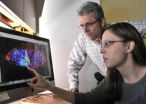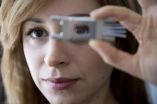(Press-News.org) Long-term brain damage caused by stroke could be reduced by saving cells called pericytes that control blood flow in capillaries, reports a new study led by scientists from UCL (University College London).
Until now, many scientists believed that blood flow within the brain was solely controlled by changes in the diameter of arterioles, blood vessels that branch out from arteries into smaller capillaries. The latest research reveals that the brain's blood supply is in fact chiefly controlled by the narrowing or widening of capillaries as pericytes tighten or loosen around them.
The study, published this week in Nature, shows not only that pericytes are the main regulator of blood flow to the brain, but also that they tighten and die around capillaries after stroke. This significantly impairs blood flow in the long term, causing lasting damage to brain cells. The team of scientists from UCL, Oxford University and the University of Copenhagen showed that certain chemicals could halve pericyte death from simulated stroke in the lab, and hope to develop these into drugs to treat stroke victims.
"At present, clinicians can remove clots blocking blood flow to the brain if stroke patients reach hospital early enough," explains Professor David Attwell of UCL's Department of Neuroscience, Physiology & Pharmacology, who led the study. "However, the capillary constriction produced by pericytes may, by restricting the blood supply for a long time, cause further damage to nerve cells even after the clot is removed. Our latest research suggests that devising drugs to prevent capillary constriction may offer new therapies for reducing the disability caused by stroke."
"This discovery offers radically new treatment approaches for stroke," says study co-author Professor Alastair Buchan, Dean of Medicine and Head of the Medical Sciences Division at Oxford University. "Importantly, we should now be able to identify drugs that target these cells. If we are able to prevent pericytes from dying, it should help restore blood flow in the brain to normal and prevent the ongoing slow damage we see after a stroke which causes so much neurological disability in our patients."
The new research also gives insight into the mechanisms underlying the use of functional magnetic resonance imaging to detect blood flow changes in the brain.
"Functional imaging allows us to see the activity of nerve cells within the human brain but until now we didn't quite know what we were looking at," explains Professor Attwell. "We have shown that pericytes initiate the increase in blood flow seen when nerve cells become active, so we now know that functional imaging signals are caused by a pericyte-mediated increase of capillary diameter. Knowing exactly what functional imaging shows will help us to better understand and interpret what we see."
INFORMATION: END
Cell-saving drugs could reduce brain damage after stroke
Long-term brain damage caused by stroke could be reduced by saving cells called pericytes that control blood flow in capillaries
2014-03-26
ELSE PRESS RELEASES FROM THIS DATE:
Should whole-genome sequencing become part of newborn screening?
2014-03-26
That question is likely to stir debate in coming years in many of the more-than-60 countries that provide newborn screening, as whole-genome sequencing (WGS) becomes increasingly affordable and reliable. Newborn screening programs – which involve drawing a few drops of blood from a newborn's heel – have been in place since the late 1960s, and are credited with having saved thousands of lives by identifying certain genetic, endocrine or metabolic disorders that can be treated effectively when caught early enough. Advocates of routine WGS for newborns argue that the new technology ...
Solar System's edge redefined
2014-03-26
Washington, D.C.—The Solar System has a new most-distant member, bringing its outer frontier into focus.
New work from Carnegie's Scott Sheppard and Chadwick Trujillo of the Gemini Observatory reports the discovery of a distant dwarf planet, called 2012 VP113, which was found beyond the known edge of the Solar System. This is likely one of thousands of distant objects that are thought to form the so-called inner Oort cloud. What's more, their work indicates the potential presence of an enormous planet, perhaps up to 10 times the size of Earth, not yet seen, but possibly ...
Penn Dental Medicine-NIH team reverses bone loss in immune disorder
2014-03-26
Patients with leukocyte adhesion deficiency, or LAD, suffer from frequent bacterial infections, including the severe gum disease known as periodontitis. These patients often lose their teeth early in life.
New research by University of Pennsylvania School of Dental Medicine researchers, teaming with investigators from the National Institutes of Health, has demonstrated a method of reversing this bone loss and inflammation.
The work was led by Penn Dental Medicine's George Hajishengallis, professor in the Department of Microbiology, in collaboration with Niki Moutsopoulos ...
Researchers present comprehensive 'roadmap' of blood cells
2014-03-26
(WASHINGTON, March 26, 2014) – Research published online today in Blood, the Journal of the American Society of Hematology, presents an unprecedented look at five unique blood cells in the human body, pinpointing the location of key genetic regulators in these cells and providing a new tool that may help scientists to identify how blood cells form and shed light on the etiology of blood diseases.
Work published today in Blood* is a subset of a much larger catalog of genetic information about nearly 1,000 human cells and tissues unveiled today from the international research ...
3-D MRI scans may offer better way to predict survival after chemo for liver tumors
2014-03-26
In a series of studies involving 140 American men and women with liver tumors, researchers at Johns Hopkins have used specialized 3-D MRI scans to precisely measure living and dying tumor tissue to quickly show whether highly toxic chemotherapy – delivered directly through a tumor's blood supply – is working.
The investigators say their findings, to be presented March 22-27 in San Diego at the annual meeting of the Society of Interventional Radiology, are the first "proof of principle" that this technology can show tumors in three dimensions and accurately measure tumor ...
Lawrence Livermore scientists discover bacterial resistance to improve biofuel production
2014-03-26
Resistance is not futile when it comes to a new method to more efficiently convert biomass to biofuels.
New research by scientists from Lawrence Livermore National Laboratory in conjunction with the Joint BioEnergy Institute (JBEI) suggests that a type of bacterial resistance may provide more efficient production of biofuels.
The team identified the genetic origin of bacterial resistance to an ionic liquid (a salt in the liquid state), which they successfully introduced into a strain of E. coli bacteria for the production of advanced biofuels. The ionic liquid resistance ...
Significant progress toward creating 'benchtop human' reported
2014-03-26
Significant progress toward creating "homo minutus" - a benchtop human -was reported at the Society of Toxicology meeting on Mar. 26 in Phoenix.
The advance - successful development and analysis of a liver human organ construct that responds to exposure to a toxic chemical much like a real liver- was described in a presentation by John Wikswo, the Gordon A. Cain University Professor and Director of the Vanderbilt Institute for Integrative Biosystems Research and Education (VIIBRE) at Vanderbilt University.
The achievement is the first result from a five-year, $19 million ...
UT Southwestern cancer biologists link tumor suppressor gene to stem cells
2014-03-26
DALLAS – March 26, 2014 – Just as archeologists try to decipher ancient tablets to discern their meaning, UT Southwestern Medical Center cancer biologists are working to decode the purpose of an ancient gene considered one of the most important in cancer research.
The p53 gene appears to be involved in signaling other cells instrumental in stopping tumor development. But the p53 gene predates cancer, so scientists are uncertain what its original function is.
In trying to unravel the mystery, Dr. John Abrams, Professor of Cell Biology at UT Southwestern, and his team ...
Biological testing tool, ScanDrop, tests in fraction of time and cost of industry standard
2014-03-26
Northeastern University professor of pharmaceutical sciences, Tania Konry, has developed a single instrument that can conduct a wide range of biological scans in a fraction of the time and cost of industry standard equipment. That's because it uses considerably less material and ultra-sensitive detection methods to do the same thing.
Currently, researchers face enormous time constraints and financial hurdles from having to run these analyses on a regular basis. Hundreds of dollars and 24 hours are what's required to scan biological materials for important biomarkers that ...
Natural history must reclaim its place
2014-03-26
Support in developed countries for natural history—the study of the fundamental nature of organisms and how and where they live and interact with their environment—appears to be in steep decline. Yet natural history provides essential knowledge for fields as varied as human health, food security, conservation, land management, and recreation. In the April issue of BioScience, a group of scientists from institutions across North America details examples supporting their conviction that a revitalization of the practice of natural history will provide important benefits for ...
LAST 30 PRESS RELEASES:
Numbers in our sights affect how we perceive space
SIMJ announces global collaborative book project in commemoration of its 75th anniversary
Air pollution exposure and birth weight
Obstructive sleep apnea risk and mental health conditions among older adults
How talking slows eye movements behind the wheel
The Ceramic Society of Japan’s Oxoate Ceramics Research Association launches new international book project
Heart-brain connection: international study reveals the role of the vagus nerve in keeping the heart young
Researchers identify Rb1 as a predictive biomarker for a new therapeutic strategy in some breast cancers
Survey reveals ethical gaps slowing AI adoption in pediatric surgery
Stimulant ADHD medications work differently than thought
AI overestimates how smart people are, according to HSE economists
HSE researchers create genome-wide map of quadruplexes
Scientists boost cell "powerhouses" to burn more calories
Automatic label checking: The missing step in making reliable medical AI
Low daily alcohol intake linked to 50% heightened mouth cancer risk in India
American Meteorological Society announces Rick Spinrad as 2026 President-Elect
Biomass-based carbon capture spotlighted in newly released global climate webinar recording
Illuminating invisible nano pollutants: advanced bioimaging tracks the full journey of emerging nanoscale contaminants in living systems
How does age affect recovery from spinal cord injury?
Novel AI tool offers prognosis for patients with head and neck cancer
Fathers’ microplastic exposure tied to their children’s metabolic problems
Research validates laboratory model for studying high-grade serous ovarian cancer
SIR 2026 delivers transformative breakthroughs in minimally invasive medicine to improve patient care
Stem Cell Reports most downloaded papers of 2025 highlight the breadth and impact of stem cell research
Oxford-led study estimates NHS spends around 3% of its primary and secondary care budget on the health impacts of heat and cold in England
A researcher’s long quest leads to a smart composite breakthrough
Urban wild bees act as “microbial sensors” of city health.
New study finds where you live affects recovery after a hip fracture
Forecasting the impact of fully automated vehicle adoption on US road traffic injuries
Alcohol-related hospitalizations from 2016 to 2022
[Press-News.org] Cell-saving drugs could reduce brain damage after strokeLong-term brain damage caused by stroke could be reduced by saving cells called pericytes that control blood flow in capillaries



